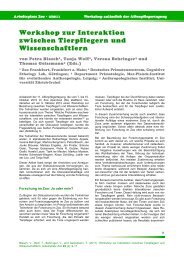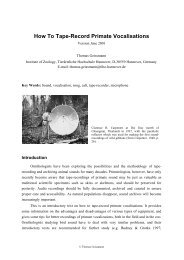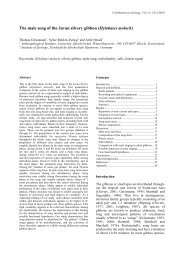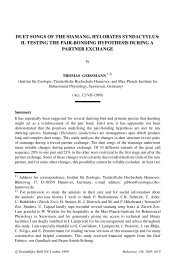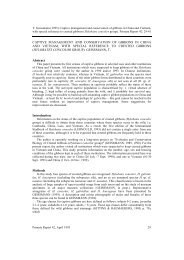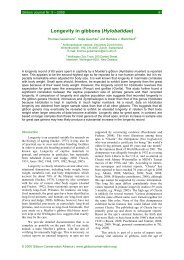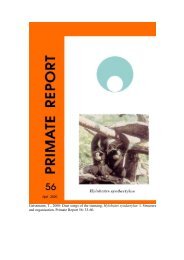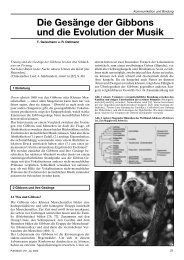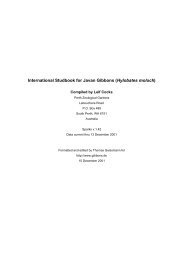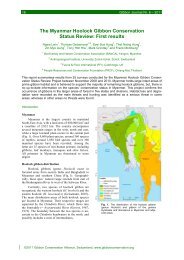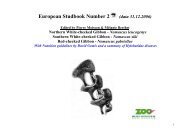Classification & Distribution <strong>of</strong> Crested <strong><strong>Gibbon</strong>s</strong>Genetically, N. nasutus is most closely related to N. ha<strong>in</strong>anus (Roos et al. 2007; Van Ngoc Th<strong>in</strong>h etal. 2010b; Van Ngoc Th<strong>in</strong>h et al. 2010e). In the mitochondrial cytochrome b gene, N. nasutus differsfrom N. ha<strong>in</strong>anus <strong>in</strong> 6.8%, and from the other crested gibbon species <strong>in</strong> 6.7-8.2% (Roos et al. 2007).N. nasutus separated from N. ha<strong>in</strong>anus about 3.2 million years ago, and from the other crestedgibbon species about 4.2 million years ago (Van Ngoc Th<strong>in</strong>h et al. 2010b).9.4.2 Western Black <strong>Gibbon</strong> Nomascus concolorAdult males and juveniles are completely black with a strongly developed crown crest. A fews<strong>in</strong>gle white hairs may occur <strong>in</strong> the corner <strong>of</strong> the mouth. Adult females are pale yellow, yellow,orange or beige brown with a black cap and a large, <strong>of</strong>ten rhomboid area with black hairs on theventral area. <strong>The</strong> amount <strong>of</strong> ventral black varies. In some females, the whole ventral fur may beblack, strongly contrast<strong>in</strong>g with the light back, at the other end <strong>of</strong> the range, the ventral fur maybe merely <strong>in</strong>terspersed with some black hairs. Description after Geissmann (1993, 1994, 1995),Geissmann et al. (2000), Groves (2001), Mootnick (2006) and Mootnick and Fan Pengfei (2011).Fully developed male song vocalizations <strong>of</strong> N. concolor consist <strong>of</strong> all three different note typesdescribed for male crested gibbons (Geissmann 1993, 1995; Geissmann et al. 2000): s<strong>in</strong>gle boomsproduced dur<strong>in</strong>g <strong>in</strong>flation <strong>of</strong> the throat sac, staccato phrases, and multi-modulated phrases(Figure 14). <strong>The</strong> first note <strong>of</strong> the multi-modulated phrase starts with high frequency (>1 kHz) andis ascend<strong>in</strong>g, followed by notes with rapid down-up modulation (u-shaped <strong>in</strong> the sonogram). <strong>The</strong>female great call consists <strong>of</strong> 9-14 notes. <strong>The</strong> first one or two notes are <strong>of</strong> ascend<strong>in</strong>g frequencyonly, the others are down-up modulated (u-shaped), with the end frequency be<strong>in</strong>g higher thanthe start<strong>in</strong>g frequency (Geissmann 1993, 1995; Geissmann et al. 2000; Van Ngoc Th<strong>in</strong>h et al.2010d; Van Ngoc Th<strong>in</strong>h et al. 2011).Figure 14. Sonogram show<strong>in</strong>g call sequence <strong>of</strong> Nomascus concolorAdapted from Van Ngoc Th<strong>in</strong>h et al. (2011).Genetically, N. concolor is more closely related to the four light-cheeked crested gibbon speciesthan to the other two all-black species N. nasutus and N. ha<strong>in</strong>anus (Roos 2004; Takacs et al. 2005;Monda et al. 2007; Roos et al. 2007; Van Ngoc Th<strong>in</strong>h et al. 2010b; Van Ngoc Th<strong>in</strong>h et al. 2010e). Inthe mitochondrial cytochrome b gene, N. concolor differs from N. nasutus and N. ha<strong>in</strong>anus <strong>in</strong> 6.8-8.2%, and from the light-cheeked crested gibbon species <strong>in</strong> 4.5-6.2% (Roos et al. 2007). N. concolorseparated from N. nasutus and N. ha<strong>in</strong>anus about 4.2 million years ago, and from the lightcheekedcrested gibbon species about 2.8 million years ago (Van Ngoc Th<strong>in</strong>h et al. 2010b).9.4.3 Northern White-cheeked <strong>Gibbon</strong> Nomascus leucogenysMales and juveniles are black with a white cheek beard connect<strong>in</strong>g under a black ch<strong>in</strong> andextend<strong>in</strong>g up to the top <strong>of</strong> the ears. <strong>The</strong> beard can rarely be pale yellow <strong>in</strong> juveniles. <strong>The</strong> beard104
<strong>The</strong> <strong>Conservation</strong> <strong>Status</strong> <strong>of</strong> <strong><strong>Gibbon</strong>s</strong> <strong>in</strong> <strong>Vietnam</strong>does not look “brushed” outwards. <strong>The</strong> fur on the chest is black, and the crown crest is stronglydeveloped. Adult females are pale yellow, yellow, apricot or orange yellow. <strong>The</strong> fur on the chestand belly is light, as the back, but <strong>of</strong>ten th<strong>in</strong>ner. <strong>The</strong> face r<strong>in</strong>g is usually white and dist<strong>in</strong>ctly lighterthan the neck; it is <strong>of</strong>ten th<strong>in</strong>, but usually complete. <strong>The</strong> cheek fur does not stand out on the sides.Description after Geissmann (1993, 1994, 1995), Geissmann et al. (2000), Groves (2001), Mootnick(2006) and Mootnick and Fan Pengfei (2011).Fully developed male song vocalizations <strong>of</strong> N. leucogenys consist <strong>of</strong> all three different note typesdescribed for male crested gibbons (Geissmann 1993, 1995; Geissmann et al. 2000): boomsproduced dur<strong>in</strong>g <strong>in</strong>flation <strong>of</strong> throat sac, staccato phrases, and multi-modulated phrases (Figure15). Booms are produced as s<strong>in</strong>gle notes, as <strong>in</strong> other crested gibbons, but <strong>in</strong> some <strong>in</strong>dividuals,they can be produced <strong>in</strong> short series <strong>of</strong> up to four notes. <strong>The</strong> first note <strong>of</strong> the multi-modulatedphrase has a long section <strong>of</strong> relatively stable frequency at the beg<strong>in</strong>n<strong>in</strong>g with a rapid down-upsweep (“hook”) at the end. Repeated changes <strong>of</strong> frequency modulation (“wou-ee-ou-ee-ou-ee”)occur on the second and <strong>of</strong>ten on the third note. <strong>The</strong> female great call consists ma<strong>in</strong>ly <strong>of</strong> 8-30 (upto 39) notes, which normally start with a frequency <strong>of</strong> more than 0.6 kHz (Geissmann 1993, 1995;Geissmann et al. 2000; Van Ngoc Th<strong>in</strong>h et al. 2010d; Van Ngoc Th<strong>in</strong>h et al. 2011).Figure 15. Sonogram show<strong>in</strong>g call sequence <strong>of</strong> Nomascus leucogenysAdapted from Van Ngoc Th<strong>in</strong>h et al. (2011).Genetically, N. leucogenys is most closely related to N. siki (Roos 2004; Takacs et al. 2005; Monda etal. 2007; Roos et al. 2007; Van Ngoc Th<strong>in</strong>h et al. 2010b; Van Ngoc Th<strong>in</strong>h et al. 2010c; Van NgocTh<strong>in</strong>h et al. 2010e). In the mitochondrial cytochrome b gene, N. leucogenys differs from N. siki <strong>in</strong>1.2-1.8%, and from the yellow-cheeked gibbons <strong>in</strong> 3.3-4.6% (Roos et al. 2007). N. leucogenys and N.siki separated about 0.5 million years ago, and both from the yellow-cheeked gibbons about 1.7million years ago (Van Ngoc Th<strong>in</strong>h et al. 2010b). N. leucogenys carries a species-specific <strong>in</strong>versionon chromosome 7 (Carbone et al. 2009).9.4.4 Southern White-cheeked <strong>Gibbon</strong> Nomascus sikiMales and juveniles are black with a white cheek beard. In contrast to N. leucogenys, the beardreaches only halfway up the ears, with a po<strong>in</strong>ted upper end and extend<strong>in</strong>g to jaw angles andform<strong>in</strong>g a bracket around the corners <strong>of</strong> the mouth (absent <strong>in</strong> N. leucogenys). <strong>The</strong> beard can rarelybe pale yellow <strong>in</strong> juveniles. <strong>The</strong> beard is not “brushed” outwards (as <strong>in</strong> N. gabriellae and N.annamensis), but flatly towards the ears. <strong>The</strong> fur on the chest is black, and the crown crest isrelatively well developed, but usually less high than <strong>in</strong> N. leucogenys. Adult females <strong>of</strong> N. siki lookvery similar to those <strong>of</strong> N. leucogenys, and no consistent fur colouration differences are knownbetween them. Description after Geissmann (1993, 1994, 1995) (1993, 1994, 1995), Geissmann etal. (2000), Groves (2001), Mootnick (2006) and Mootnick and Fan Pengfei (2011).105
- Page 2:
The Conservation Status of Gibbons
- Page 7:
The Conservation Status of Gibbons
- Page 10 and 11:
A site is defined in this report as
- Page 12 and 13:
Abbreviations and Acronymsa.s.l. ab
- Page 14 and 15:
carried out in 2000 and 2001. At Ho
- Page 16 and 17:
ConclusionsWhile gibbons are afford
- Page 18 and 19:
IntroductionChapter 1IntroductionFe
- Page 20 and 21:
Introductionexperienced conservatio
- Page 22 and 23:
The Conservation Status of Gibbons
- Page 24 and 25:
The Conservation Status of Gibbons
- Page 26 and 27:
The Conservation Status of Gibbons
- Page 28 and 29:
The Conservation Status of Gibbons
- Page 30 and 31:
The Conservation Status of Gibbons
- Page 32 and 33:
The Conservation Status of Gibbons
- Page 34 and 35:
The Conservation Status of Gibbons
- Page 36 and 37:
Nomascus nasutusChapter 3Eastern bl
- Page 38 and 39:
Nomascus nasutus3 Eastern Black Gib
- Page 40 and 41:
Nomascus nasutusrecorded on an ad h
- Page 42 and 43:
Nomascus nasutusand field surveys,
- Page 44 and 45:
Nomascus concolorChapter 4Western b
- Page 46 and 47:
Nomascus concolor4 Western Black Gi
- Page 48 and 49:
Nomascus concolorwill provide incre
- Page 50 and 51:
Nomascus concolorthose in neighbour
- Page 52 and 53:
Nomascus concolorDat & Le Minh Phon
- Page 54 and 55:
Nomascus leucogenysChapter 5Norther
- Page 56 and 57:
Nomascus leucogenys5 Northern White
- Page 58 and 59:
Nomascus leucogenys5.3 Nomascus leu
- Page 60 and 61:
Nomascus leucogenysNguyen Manh Ha e
- Page 62 and 63:
Nomascus leucogenysThe reserve mana
- Page 64 and 65:
Nomascus leucogenys5.3.10 Pu Mat Na
- Page 66 and 67:
Nomascus leucogenysStatusA 13 day s
- Page 68 and 69:
Nomascus leucogenysDuong Anh Tuan 2
- Page 70 and 71: Nomascus sikiChapter 6Southern whit
- Page 72 and 73: Nomascus siki6 Southern White-cheek
- Page 74 and 75: Nomascus siki6.2.5 Priority Conserv
- Page 76 and 77: Nomascus sikithese vagaries, the pa
- Page 78 and 79: Nomascus sikifield records (Le Manh
- Page 80 and 81: Nomascus annamensisChapter 7Norther
- Page 82 and 83: Nomascus annamensis7 Northern Yello
- Page 84 and 85: Nomascus annamensisStatusThis site
- Page 86 and 87: Nomascus annamensisThreats and Cons
- Page 88 and 89: Nomascus annamensisDate of most rec
- Page 90 and 91: Nomascus annamensisThreats and Cons
- Page 92 and 93: Nomascus annamensisgroups) and 148
- Page 94 and 95: Nomascus annamensisThreats and Cons
- Page 96 and 97: Nomascus gabriellaeChapter 8Souther
- Page 98 and 99: Nomascus gabriellae8 Southern Yello
- Page 100 and 101: Nomascus gabriellae8.2.4 Ongoing Co
- Page 102 and 103: Nomascus gabriellae8.3.4 Chu Yang S
- Page 104 and 105: Nomascus gabriellaeThreats and Cons
- Page 106 and 107: Nomascus gabriellaeDate of most rec
- Page 108 and 109: Nomascus gabriellaepark-wide census
- Page 110 and 111: Nomascus gabriellaeStatusThis reser
- Page 112 and 113: Classification & Distribution of Cr
- Page 114 and 115: Classification & Distribution of Cr
- Page 116 and 117: Classification & Distribution of Cr
- Page 118 and 119: Classification & Distribution of Cr
- Page 122 and 123: Classification & Distribution of Cr
- Page 124 and 125: Classification & Distribution of Cr
- Page 126 and 127: Ecology & Behaviour of Crested Gibb
- Page 128 and 129: Ecology & Behaviour of Crested Gibb
- Page 130 and 131: Ecology & Behaviour of Crested Gibb
- Page 132 and 133: Ecology & Behaviour of Crested Gibb
- Page 134 and 135: References11 ReferencesAbramov, A.
- Page 136 and 137: ReferencesDang Ngoc Can, Pham Duc T
- Page 138 and 139: ReferencesGeissmann, T., Nguyen Man
- Page 140 and 141: ReferencesLa Quang Trung, and Trinh
- Page 142 and 143: ReferencesLuong Van Hao, and Le Van
- Page 144 and 145: ReferencesNguyen Quang Hoa Anh, Tha
- Page 146 and 147: ReferencesSrikosamatara, S., and S.
- Page 148 and 149: AnnexesAnnex 1. Summary of Gibbon R
- Page 150 and 151: AnnexesSiteProvinceArea(ha)Minimum
- Page 152 and 153: Annexesd) number of locations or su
- Page 154: Annexesc) area, extent or quality o



